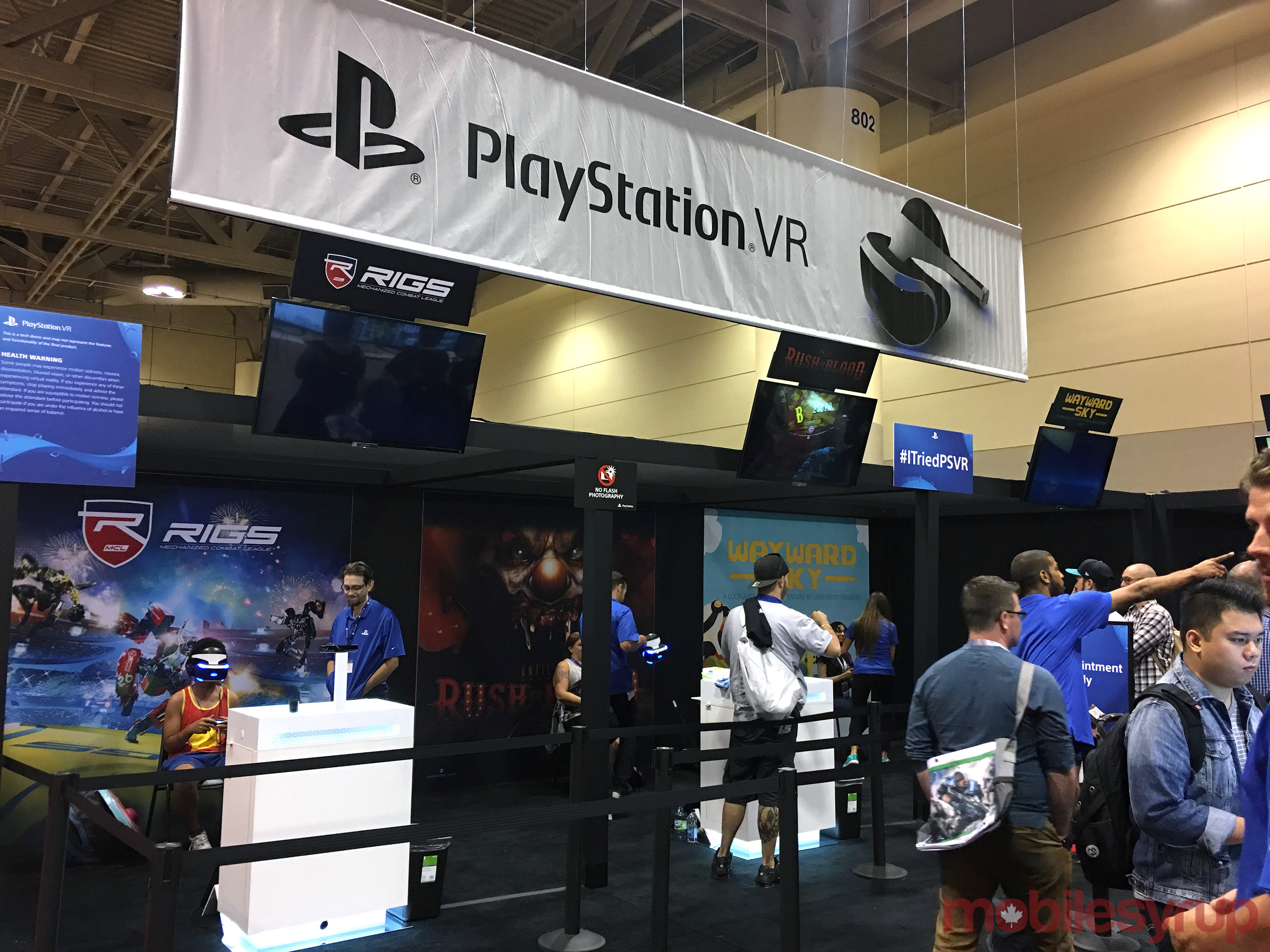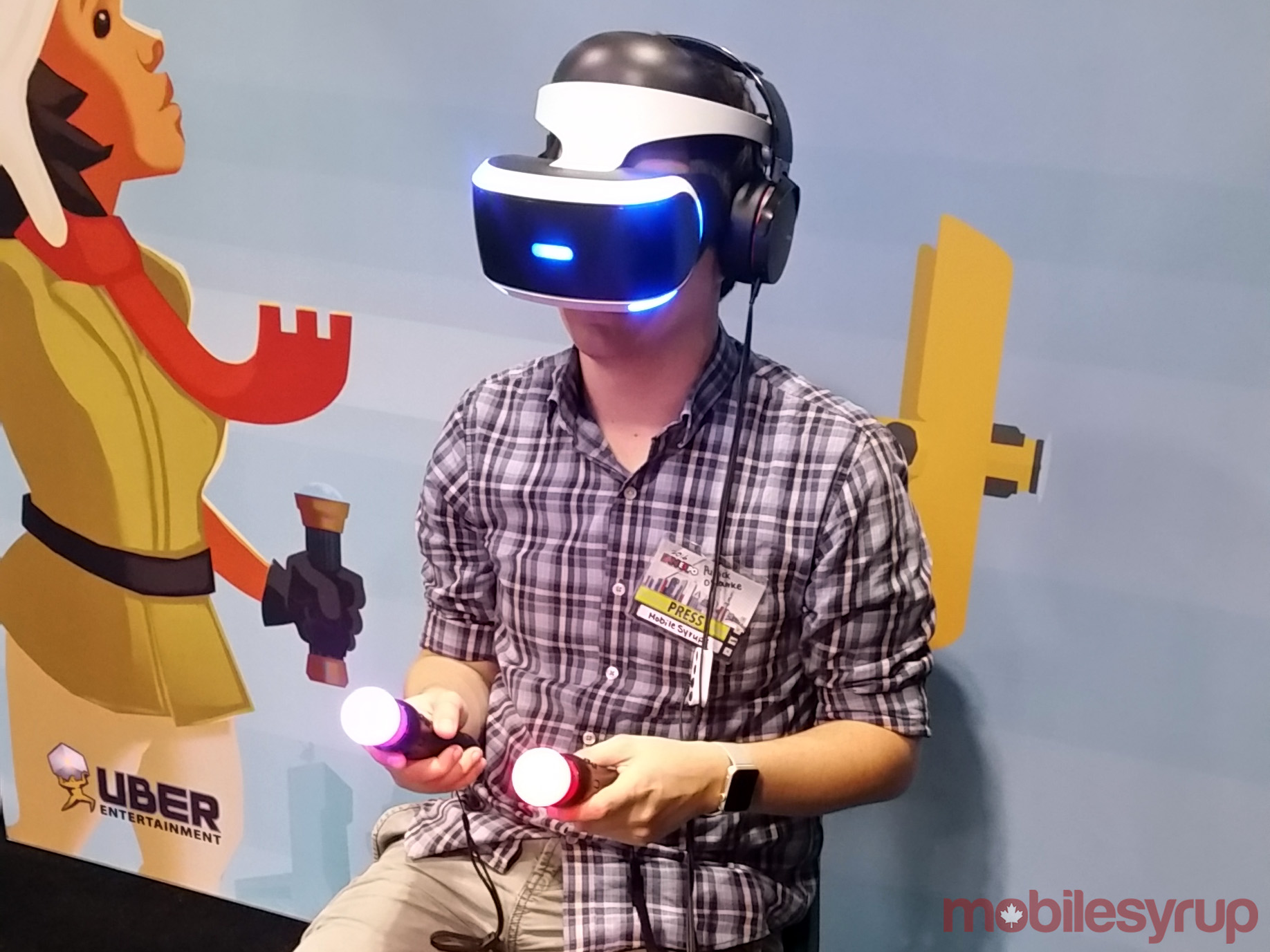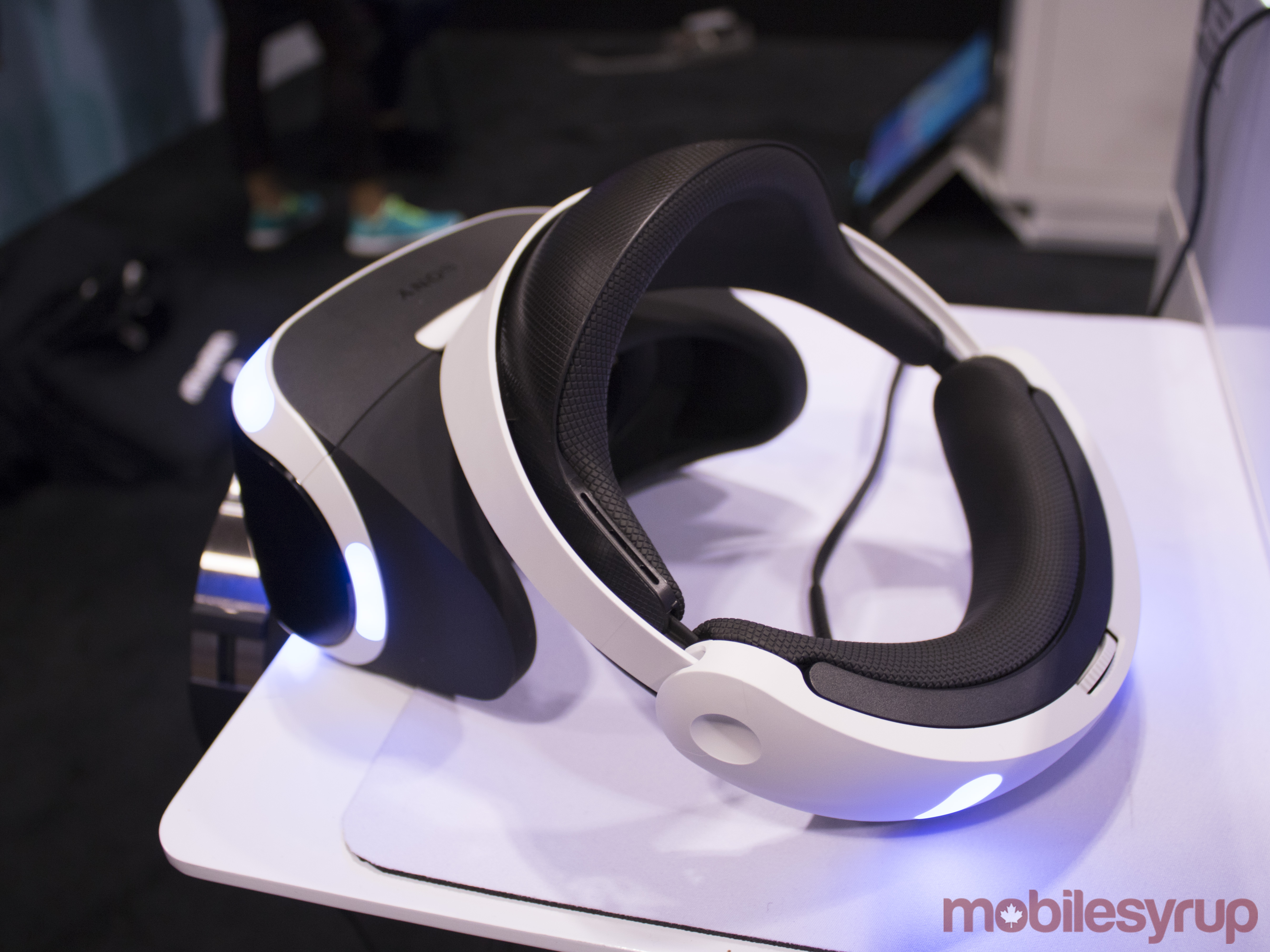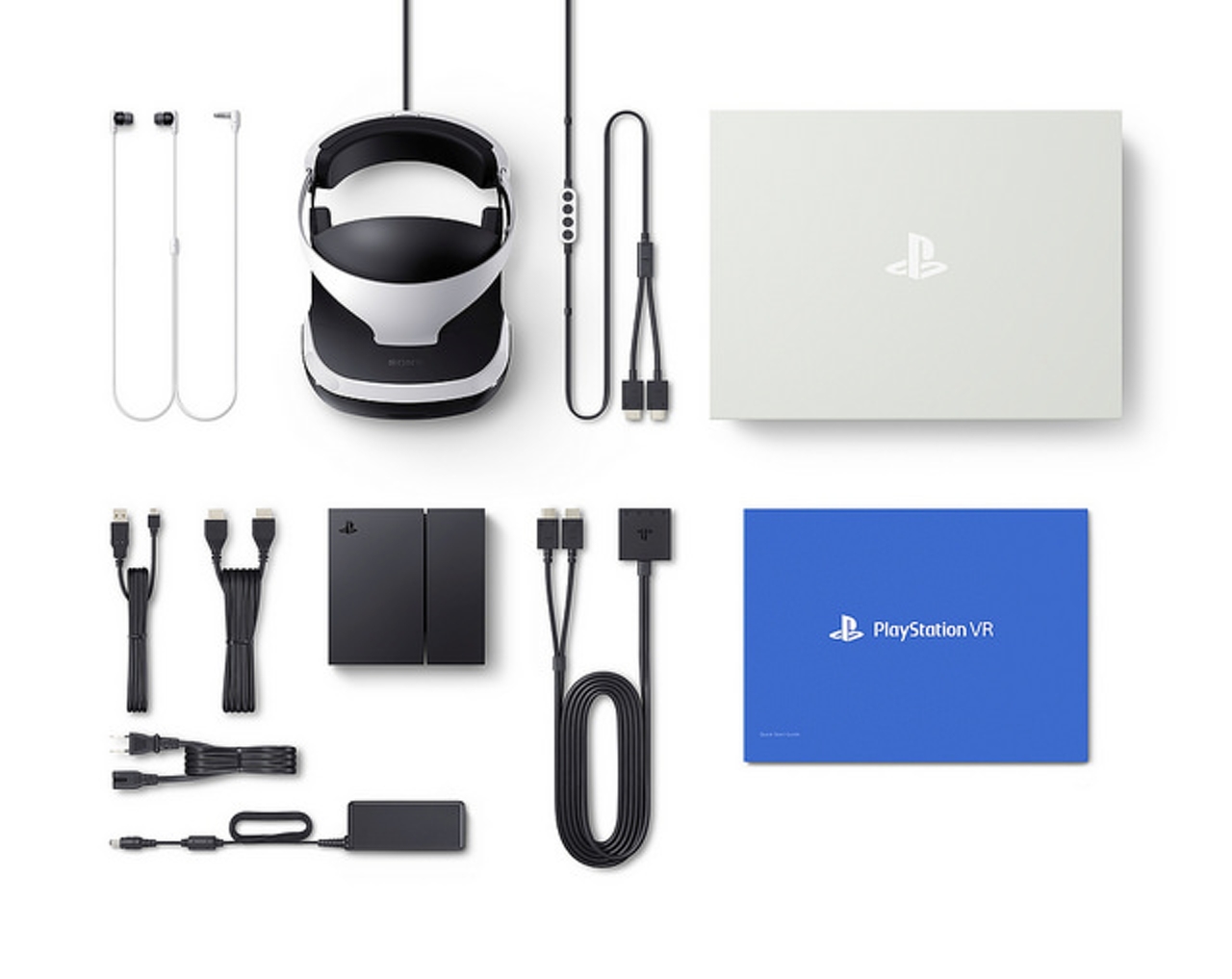
PlayStation VR is far from perfect, but it’s likely high-end VR’s top chance at mainstream success, at least in the burgeoning industry’s current state.
Over the past few days, I’ve had two opportunities to go try the final retail version of PlayStation VR, one at Sony’s PS VR demo station in Sherway Gardens mall in Toronto, and the other more extended hands-on at Fan Expo Canada. While I went into both demos optimistic about PlayStation VR’s potential, I walked away pleasantly surprised with what the high-end headset is capable of.
The final retail build of PS VR is extremely comfortable, more so than even the Oculus Rift and somewhat awkward HTC Vive. On the crowded, increasingly sweaty show floor at Fan Expo in Toronto, Sony’s headset felt light and positively breezy, especially when compared to my almost always sweaty experience with the Vive, even when my air conditioning is blasting throughout my apartment.
The headset itself, however, does have a flimsy feel to it when compared to its competitors, though this is also likely why it feels light, so there are some benefits. Adjusting PS VR’s fit is also easy and can be performed via a button located on right side of the headset’s base, allowing the wearer to shift display distance in a simple, intuitive way. PlayStation VR doesn’t feel front heavy like the Rift or Vive and the strap that holds the device to your head is comfortable when compared to the headset’s competitors, sliding right onto my head with minimal adjustments.
It’s important to point out that much like the Oculus Rift — at least until its touch controllers and base stations launch — PlayStation VR lacks the room-scale functionality the Vive is capable of. Once you’ve experienced room-scale and the ability to physically interact with a virtual world, it’s hard to go back.
With this said, given the fact that there are approximately 30 million PlayStation 4’s in the world right now, PS VR is poised to be significantly more successful than both the Vive and Oculus, despite the headset’s technical limitations stemming from it being powered by the PS4.
Wayward Sky — Third Person VR
Waywward Sky from Uber Entertainment is different from any other virtual reality title I’ve played in the past. Rather than adopting a first-person perspective, this puzzle game is a mix between a top-down view where the player points the PlayStation Move controllers to navigate their character, and short first-person sequences primarily involving pulling levers or pressing VR buttons.
I found this method of interaction jarring at first, but after five minutes with the game, the interaction began to feel seamless. Plot-wise, the game follows the journey of Bess a young co-pilot flying with her father when the pair crash into a mysterious cloud fortress.
When playing in first person mode, Wayward Sky’s camera acts as your head, with screen ‘blinks’ inserted into the experience — this was used in Vancouver-based Cloudhead Games’ Call of the Starseed to negate player motion sickness — between areas to help the player guide Bess through puzzles.
Still, despite how impressed I was with the experience in terms of visuals and utilizing VR to offer a unique perspective of a virtual world, it’s difficult to see how Wayward Sky, similar to many virtual reality games, will remain compelling across a longer, multi-hour experience.
The game’s visuals are surprisingly impressive and actually on par with what I’ve seen from many high-end HTC Vive titles. Visual fidelity is something I’ve been concerned about with PlayStation VR because the headset is tethered to the PlayStation 4, an under-powered console compared to modern mid-range gaming PCs.
However, at least right now, PS VR’s visuals are on par with what other high-end headsets offer, despite its 960 x 1080 pixel resolution displays, slightly less than the 2160 x 1200 pixel screens included in the Vive and PlayStation VR.
Until Dawn: Rush of Blood is a great demo, but little more
Supermasssive Games’ Until Dawn: Rush of Blood — the studio is also behind last year’s sleeper hit Until Dawn — is a great way to show people how VR can be used to evoke a palpable sense of fear. Visually the game is impressive and what I would describe as an ‘experience’ worth delving into, but at least from what I saw, the game doesn’t seem to offer much actual gameplay.
Rush of Blood takes place on rails and has the player moving through various frightening environments filled with jump scares, all while occasionally shooting at targets. While I’m not the type of person who scares easily, the woman beside me playing the game spent the entire 15 minute demo swearing and screaming, partly because she was just that engrossed by the experience (I think), but also because I feel like she was acting out her personal Twitch stream live, in the real-world for Fan Expo attendees waiting in line to enjoy.
So while some users will likely find Rush of Blood downright terrifying, after playing truly scary titles like the Brookhaven Experiment on the HTC Vive that take advantage of room-scale to an extent, the jump scares present in Supermassive Games’ latest title feel pedestrian.
Tethered VR’s best chance
Despite the headset’s obvious hardware limitations and only trying a small number of titles — I also went hands-on with Eve Valkyrie at Sherway Gardens, a game I’ve tried on the Vive and Oculus and felt the experience was nearly identical — I walked away cautiously optimistic with Sony’s take on high-end virtual reality.
For some, PS VR will be their first experience with high-end virtual reality, if only because it’s the most affordable and simple option, especially if you’re already a PS4 owner.
However, many questions still remain about Sony’s headset, mainly surrounding how much space PS VR actually needs to operate, as well as if it actually ends up being easy to set up like Sony claims. We’ll have more on PlayStation VR leading up to the headset’s launch, including a full review.
PlayStation VR is set to launch on October 13th in Canada for $549, which includes the headset, cables, stereo headphones and a demo disk. The more comprehensive $699 launch bundle features everything above, but also the PlayStation Camera and two PlayStation Move remotes, which are required for most games.
If you want to try out PlayStation VR for yourself, check out this interactive map Sony’s created listing the headset’s various public demo stations across Canada.
Related: Bustin’ the paranormal in The Void’s Ghostbusters VR experience [Reality Bytes]
MobileSyrup may earn a commission from purchases made via our links, which helps fund the journalism we provide free on our website. These links do not influence our editorial content. Support us here.






